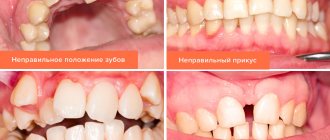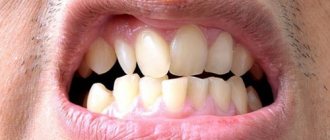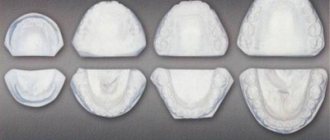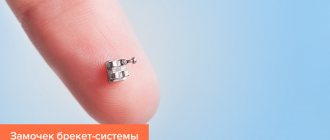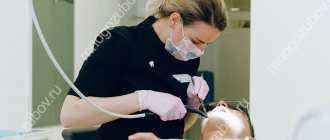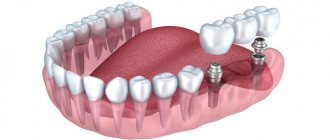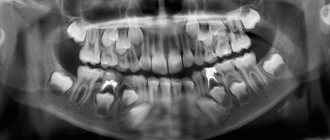In what cases is teeth straightening necessary?
Smooth and beautiful teeth are the dream of many people. After all, not everyone was given a perfect smile at birth. Dental abnormalities can be the result of poor heredity, trauma, or improper dental care in childhood. If you clearly see that your teeth are crowded, your teeth protrude greatly from the dentition, or there are other deficiencies, you should contact an orthodontist. Sometimes the problem is far-fetched, but only a specialist can determine this. A preliminary diagnosis will be made at the first appointment, and then the doctor will be able to offer treatment options.
Age for correcting malocclusion in children
You should think about visiting an orthodontist after teething. If necessary, the specialist will prescribe a comprehensive examination and radiography to identify the causes of dental anomalies. Then you should get advice from doctors in related fields. Specialists will determine contraindications, the likelihood of complications and assess the condition of the baby’s entire body. Based on the data obtained, the orthodontist will draw up a treatment plan for approximately 2 years with monthly clinic visits.
Is it possible to straighten teeth in adults?
Of course, treatment is faster in children and adolescents. This is due to the fact that up to the age of 25 in a person, the processes of bone tissue regeneration proceed faster, the ossification of bone sutures has not yet been completed, which means orthodontic treatment will be more effective. But don’t think that adults can’t be helped. Dentists have been successfully helping straighten teeth for patients of any age for a long time. It just takes a lot of time. Orthodontists typically recommend braces or aligners as options for straightening teeth in adults. In some cases, if only one or two teeth are misaligned, doctors may use veneers. These extremely thin dental coverings provide a quick solution to the problem of an imperfect smile. If the problem is several teeth and in addition the doctor diagnoses malocclusions, you will still have to use orthodontic structures.
Exercises to correct bite in children
The orthodontist selects exercises to correct the bite individually for each child, taking into account the structural features of the jaw and the severity of the pathology. Myogymnastics can be performed by parents themselves, who have learned the technique from a specialist, or by teachers and nurses in groups of children with the same disabilities.
- The lesson includes several exercises for the muscles of the tongue and oral cavity.
- Hold a sheet of cardboard with your lips while breathing through your nose.
- Move your lower jaw forward, biting your upper lip with your teeth.
- Pull out your lips with a tube.
- Puff out your cheeks with your lips closed.
- Massage your lips.
- “Click” your tongue.
- Touch each tooth with your tongue one by one.
- Hold some water in your mouth while breathing through your nose.
Myogymnastics must be performed daily at the same time until fatigue appears, taking short breaks between exercises. Only in this case will it be effective and bring the expected results.
Is it possible to straighten teeth at home?
Surely many people are interested in whether it is possible to straighten teeth at home. Don’t think that this can be done with the wave of a magic wand or using folk remedies. Teeth straightening at home means the use of aligners, trainers or elastopositioners. You will not be able to choose these designs yourself. You will need to contact an orthodontist - a doctor who straightens teeth, who will conduct an examination and tell you exactly whether removable structures will help in your case. Without a specialist, you won’t be able to cope with your problem - you shouldn’t even try. Attempting to straighten teeth without an orthodontist can lead to irreversible consequences.
How to straighten teeth for an adult?
Usually, correcting the bite and straightening the teeth is usually done in childhood. At an early age, these are removable structures, for example, trainers, lip bumpers or stretching plates; starting from the age of 10–11, braces can be installed. In some cases, you can do without braces, but the orthodontist will again tell you about this. For adults, it is more difficult to carry out the procedures. The fact is that at the age of 25, a person’s bone sutures harden, and any manipulations with the bite and other problems begin to take quite a lot of time. But this does not mean that you should give up dreams of a perfect smile. Answer to the question: “Is it possible to straighten teeth at 30 and beyond?” - of course, yes. At the first appointment, the orthodontist will tell you how to straighten teeth for an adult and what exactly to use in your case.
What is better: braces or plates?
You can choose dental plates or braces for a course of treatment only after an examination in the orthodontist’s office, following his recommendations. The structures influence the formation of the bite, but the mechanism of their action is different.
Dental plates
There is no lower age limit. They can be used in preschool age, when the child is already able to cooperate with the doctor. These are removable models.
The active element is arches that help the teeth take the correct position in the row. But the effect of the device on molars is limited. The design can prevent further bite deformation. Listen to your dentist's recommendations. Often, timely measures taken during a sensitive period help to avoid problems that will begin in a few years if there is no intervention.
In children, this orthodontic instrument allows you to change the width of the palate or restrain the development of pathological processes. It also prepares the jaw apparatus for the installation of braces in the future in case of a serious anomaly. In difficult cases, plates can be used until the molars appear, and then, in adolescence, braces need to be installed.
Braces
Any brace system is a non-removable structure. Installation and removal of braces is possible only in the office of an orthodontist. The system is capable of correcting complex combined malocclusions. Braces can be installed only from 11-13 years of age if most molars are present.
Properly installed braces:
- eliminate crowding of teeth,
- adjust the gaps between them,
- change the relative position of the jaws - stimulating or inhibiting their development.
When correcting complex anomalies, the child may need to wear a plate or retainer after braces to secure the result.
Adults and children
Dental plates are installed for children with milk units. During this period, the baby’s bite is formed, and the teeth are gradually replaced by permanent ones. Sometimes minor defects begin to progress and timely actions of the orthodontist will prevent the problem or prepare the jaw apparatus for gentle treatment. Dental plates are not used to change the bite of adults. This orthodontic instrument is needed to maintain results after wearing braces.
What ways are there to straighten teeth?
An orthodontist straightens teeth in several ways, as we have already mentioned. Let's talk about the most popular ones. The most popular way to straighten teeth is still the use of braces. Braces vary in material, location on the teeth and the presence of a ligature. However, regardless of the type, they regularly perform their functions - treating almost all malocclusions and incorrectly positioned teeth. You can inexpensively straighten your teeth and get rid of other problems by wearing metal vestibular (located on the outside of the dentition) braces.
If braces are not an option for you, you can straighten your teeth without braces using aligners. They solve several dental problems at once - they remove gaps between teeth, correct crowding and other malocclusions. One of the most popular brands is Invisalign aligners. Mouthguards are created taking into account individual characteristics, do not break and are almost invisible when worn. You can get used to them quite quickly. On average 10 – 12 hours. However, you will need to wear such mouthguards for more than 20 hours every day. You will need to accustom yourself to this, otherwise you will not achieve a good result.
Teeth straightening devices
There are two most popular orthodontic teeth straightening systems - braces and aligners (aligners). Each has its own characteristics. Braces have been used for many decades. They differ in several parameters, for example, in material. All types of braces are equally effective. This method of treatment is time-tested. In addition, braces systems are improved every year. Even metal braces have changed and turned from creepy “brackets” into a rather neat design. In parallel with bracket systems, other technologies are also developing. Thus, several years ago Invisalign aligners became widely used. Despite the high cost, their popularity has grown in a matter of months due to the following advantages:
- are created individually for each patient, taking into account his physiological characteristics
- invisible to others
- convenient for daily use
- do not require complex care
Braces
The designs allow you to level out any, even the most complex pathologies. The device consists of the braces themselves, which are individually attached to the teeth, and an arch - under its pressure, the dentition is rearranged into the correct position. Depending on the complexity of the anomaly, you will have to wear the device from six months to two years, regularly visiting a doctor. He will record changes and adjust the system. The main disadvantage of braces is their visibility, but today there are models that provide the opportunity to hide the treatment process from others. For example, ceramic and sapphire systems are white and blend in with the enamel, and lingual braces are completely invisible because they are installed on the inner wall of the teeth.
Aligners
Another device for straightening teeth is silicone aligners. They are made from transparent material based on the patient’s personal jaw casts, so they are completely invisible on the dentition. Another advantage of aligners is that they can be removed during meals or, for example, business negotiations. Treatment with aligners does not require frequent adjustments; it is enough to visit an orthodontist once every two months. You yourself change the devices from the kit every two weeks, the doctor only monitors the process. The device must be worn at least 22 hours a day, then the first results will appear within a month.
Prosthetics
For minor crooked teeth, crowns or veneers are used. They do not correct real teeth, but only mask malocclusions, but you can see the effect immediately after installing the structures. Crowns are used if the teeth are more than half destroyed - they are ground down and dentures identical to natural teeth are put on. Veneers are fixed in the smile area and hide aesthetic defects such as chips or gaps between teeth. The structures are created individually for each patient - the specialist selects the desired color and then gives them the anatomical shape of the surface of the teeth. However, these records have one significant drawback. Which? We'll talk about this below.
Massage can speed up healing
There are several ways to make the process of correcting dental anomalies less painful. One of them is massage of the gums and palate. Experts recommend using this method during oral care procedures. Gently, without force or sudden movements, massage the gums with a medium-hard brush, performing circular movements on each jaw. This will improve blood circulation, speed up the process of straightening the teeth, reduce pain, and if repeated regularly, strengthen the gums and prevent loosening of the teeth.
Surgical teeth straightening
Is it possible to straighten teeth surgically? We can say that it is impossible to surgically correct the position of the teeth, but it is possible to change the bite. The surgical method of bite correction is used only when orthodontic treatment alone is not enough.
Surgical correction of the bite, or orthognathic surgery, is only indicated for patients with noticeable skeletal deformities that result in abnormal jaw and chin size. The operation is performed in a hospital setting under general anesthesia; the entire procedure usually takes about 6 hours. Like any other major surgery, this procedure has a recovery period. The patient will be able to return to a full life after 3 to 4 weeks. However, in any case, treatment always begins with orthodontic teeth straightening, followed by a surgical stage, after which final orthodontic correction is necessary.
Types of plates for teeth
Plates for teeth are divided into two main types:
- removable;
- permanent.
The differences lie in the specifics of wearing the plates. Removable structures can be removed at any convenient time when the patient needs it. For example, for more comfortable chewing of hard food or self-tightening of the adjusting screw. However, dentists do not recommend doing this too often, since the effect of such treatment may be minimal. It is especially important to leave the dental guard in your mouth while you sleep. In general, the period of wearing the structure should be at least 22-23 hours a day.
As for permanent ones, they are installed and removed exclusively by a specialist. Such devices are used for more serious dental defects. They are also often prescribed to young children, who may not listen to the doctor’s recommendations and independently remove the plate for a long time, for example, to go to school.
In what cases is grinding necessary?
As we have already said, veneers are used to correct minor defects in the dentition - for example, chipped teeth, curvature of one or two teeth, as well as diastema. The main disadvantage of this method is the grinding of dental tissue to remove all irregularities. In addition, if you do not prepare your teeth before installing veneers, then after prosthetics they will look too convex and unnatural.
The structures themselves will last about ten years, after which they must be replaced with new ones, since turning teeth is an irreversible process.
Important!
To fix the veneers, the patient’s teeth are ground down by approximately 0.3 - 0.7 mm.
Record care
For full treatment, you need to wear the plates constantly, removing them only during meals and before bed. In order for the structure to last as long as possible, it should be properly cared for.
· Before the next fixation, the plate should be washed under running water.
· Clean the structure in the morning and evening with soft toothbrushes, using special gels or regular toothpaste.
· Once a week, the record should be soaked overnight in cleaning concentrate, and if necessary, use deep cleaning products.
It is advisable that parents supervise the process of wearing and caring for dental plates. If used irregularly, the treatment process may be prolonged and its effectiveness may decrease. In addition, with poor oral hygiene or errors in the care of the structure, additional dental problems may arise, for example, the development of caries, plaque deposits and tartar formation.
How do teeth become straight?
After the patient has been fitted with braces or has started treatment with aligners, the process of teeth straightening begins. The constant slight impact of the orthodontic system leads to the fact that the bone around the tooth changes: on the one hand it increases, and on the other it decreases. And the tooth moves to the desired point. It is important that the load is not excessive or insufficient - in either case, the treatment will not lead to the desired result. But an experienced orthodontist will not allow this to happen. It is to regulate the process of teeth straightening that you need to regularly visit your doctor. Treatment will last 1.5 – 2 years. After this, you will have to wear retainers for some time to fix the result.
Differences between aligners and braces
There are several differences, but they are significant:
- Aesthetics – unlike braces, plastic aligners are not visible.
- Mechanics of influence - aligners apply even pressure on all teeth, with simultaneous rotation and displacement in a given direction due to their tight coverage. Braces provide consistent displacement in the desired direction and rotation.
- Removable - the aligners are removable, there is no need to change your diet, and oral hygiene is simplified.
- Allergenicity - aligners are made of hypoallergenic plastic, and most models of braces are made of metal.
- Installation time – the plates are installed in 45-60 minutes. Fixed models - in 3-6 hours.
- The treatment period with mouth guards is 30% faster.
When wearing braces, there is a risk of tooth decay. This is impossible with aligners. There is no need to use cleaning brushes or dental floss to care for your aligners. For non-removable systems, the use of cleaning devices is mandatory. A patient who wishes to purchase polymer plates can see the final result before starting treatment.
How to straighten your front teeth?
In some cases, the dentition has slight deficiencies, for example with the front teeth. The orthodontist will tell you how to straighten your front teeth. He may recommend getting braces or treatment with aligners. However, sometimes cosmetic dentistry can help straighten the two front teeth. If there are no bite defects, you should consult an orthopedist - a doctor who specializes in prosthetics. He can offer the option of installing a veneer - an overlay 0.5 - 0.7 mm wide, which allows you to make your smile perfect. This technology has its pros and cons. An undoubted advantage is the speed with which the installation is carried out - just a few days, and the problem is solved. Here's a way to quickly straighten your teeth. Another plus is the service life. One of the disadvantages is the need to grind the tooth, and this is an irreversible process. In the same way, you can straighten 1 tooth, and not necessarily the front one. Sometimes an orthodontist suggests straightening the lower teeth without using braces or aligners and using veneers or lumineers. In each specific case, consultation with a doctor is necessary.
How to wear dental plates - recommendations for children and parents
Whether dental plates help is the main concern of parents. Much depends on how correctly the young patient wears the orthodontic apparatus.
The main requirements for wearing orthodontic plates:
- duration – up to 20-22 hours daily;
- care - morning and evening cleansing with pastes, gels, weekly deep cleansing in a special solution;
- remove the product when eating;
- Do not play with the orthodontic appliance - remove it and return it to its place in the mouth with your tongue.
The doctor will show you how to put the plate on your teeth at your appointment, but there is nothing complicated about it. Metal arches fix the structure, and the regulatory elements are responsible for gentle correction of the bite while wearing.
It happens that a child takes the product out of his mouth, and then cannot figure out how to put the plate on his teeth - it either falls off or does not fit into place. Such a circumstance may be preceded by the following events:
- the device was in the mouth for less than 12-14 hours a day, and the fixation was broken;
- supporting units have been removed or fallen out – the structure requires orthodontic correction;
- a tooth erupts under the polymer part of the system and prevents it from taking the correct position;
- the plate was not worn for several days in a row - the bite has returned to its original position and you need to see a doctor to adjust the device;
- violation of medical recommendations for wearing removable plates - it is worth coming to an appointment and checking the condition of the product.
Where can I straighten my teeth and how long will it take?
It is better to choose a dental clinic for bite correction carefully. Ask your friends and acquaintances if they can recommend where to straighten your teeth. Get acquainted with clinic websites and reviews of doctors’ work. A little research will save you from possible disappointment. An extremely low price should alert you: in such cases, the clinic probably simply does not indicate the cost of additional procedures.
The duration of treatment and price depend on the diagnosis made by the orthodontist. Usually, the doctor can immediately determine exactly in what period it will be possible to straighten the teeth and how much time it will take. Usually, on average, it takes 1.5 – 2 years to straighten teeth with braces. It is impossible to say which braces straighten teeth faster. All braces are effective. Except that with plastic braces, treatment may take longer - they break, and the doctor has to replace parts of the structure, and this delays the treatment time. If you only need to fix one or two teeth and you decide to get veneers, the entire treatment is unlikely to take more than 2 weeks.
There are many ways to straighten your teeth. You just have to decide to change your smile, and after a while you will definitely achieve it. The question of whether teeth need to be straightened should not even arise. Of course you need it! With a beautiful smile, most likely, your attitude towards yourself and the world will change for the better!
In the modern world, teeth straightening is a standard procedure that millions of people of different ages undergo. The fact is that a beautiful smile is not only the key to personal success, but also a means of maintaining health. Some dental abnormalities can cause diseases of various body systems. If you are looking after your health, you should not ignore the presence of dental anomalies. Straightening your teeth and making your smile perfect is not so difficult, and the result will delight you for the rest of your life!
